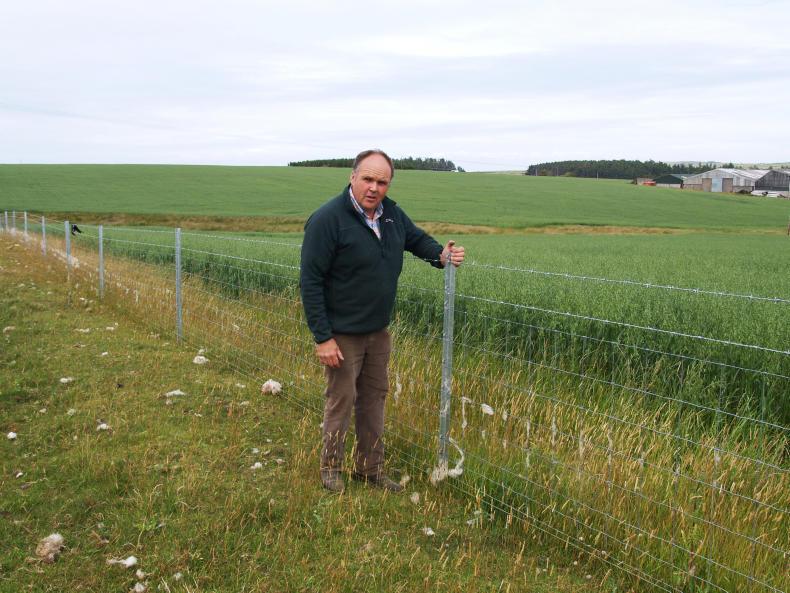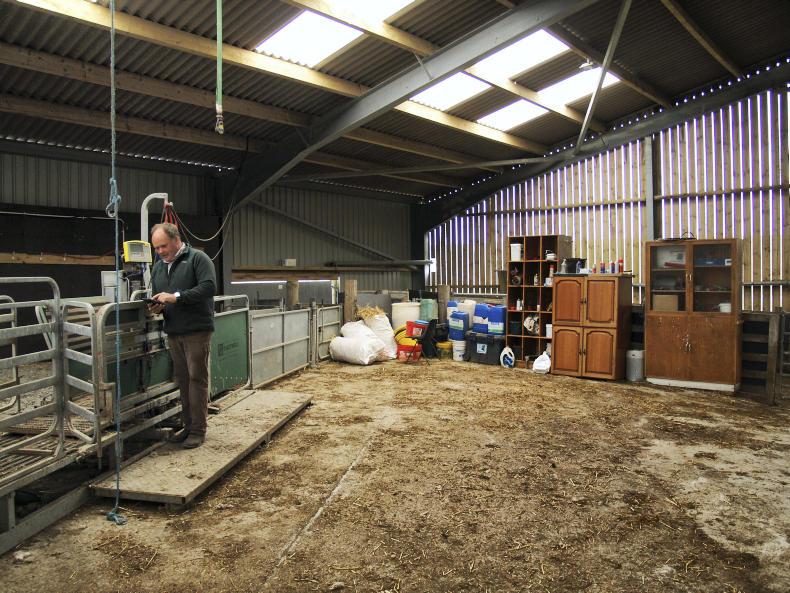Taldale Farm, situated just a few miles west of Thurso, is home to Donald MacDonald who farms in partnership with his wife Fiona, along with one full-time member of staff. At Taldale, Donald and Fiona manage a flock of 900 sheep, not including followers which are predominantly hill Cheviots. Both New Zealand Suffolk and Beltex rams are used at the farm. The first batch of lambs are sold as stores at Dingwall, usually in August, with the remaining lambs being sold in December as fat. Donald also breeds all of his own replacements.
Taldale Farm is spread across just under 600ac, with around 40ac being cut for silage each year. As well as the farm, Donald also runs a landscaping business.
The farm steading and ground is very much exposed and so Donald tries to preserve the Caithness flagstone dykes, as they provide invaluable shelter for the sheep. He also regularly uses portable cattle grids throughout the farm as he noted “it’s much nicer than opening gates”.
Sheep handling facilities
Donald’s fank appears to be the hub of the farm and the sheep handling facilities were built in 2006 following a lot of research into what would suit their steading. However, the facilities were only latterly incorporated into a shed about five years ago, providing shelter which has added to its versatility. As well as providing a covered handling facility, the pens are now used as nurseries during lambing. A smaller door adjacent to the main door of the fank’s shed was also placed due to the exposure of the farm and so that at lambing time it can be left slightly open which Donald believes is important. “You can pop your head in without disturbing the sheep. I think your ears are so important at lambing time as you can usually hear a sheep lambing,” he said.
The shed can hold 500 ewes with 750 lambs all under the one roof. There are concrete strips in the shed but most of the flooring consists of a gravel base, with straw bedding used during lambing. Prior to lambing, 2-3t of lime is scattered around the pens to limit disease and infections - the lime is also beneficial to the ground afterwards.
At the heart of the fank is a remote-controlled automatic shedder, which uses a ‘magic eye’ and has the capacity to shed 600 sheep per hour. The shedder can sort sheep by either their EID or weight. On the race there is also the addition of a large mounted mirror which encourages sheep along the race, as a sheep will see its own reflection and move towards it. After the race and shedder, the handling pens have been designed in such a way that there is the capacity, and choice, for the sheep to be sorted again.
Donald is keen to learn and try different ideas with the aim of being more efficient and profitable. He said: “Each year we ask ‘what can we do to make our lambing better?’ and we will change things, even little things, like adding a gate in somewhere or thinking of ways to add some more pens.
“Every farmer needs to look at ideas that fit their system.” Two such ideas that Donald has recently incorporated into his farming practices are a new bale wrap and metal fencing.
Silostop
Donald makes around 300 bales of silage each year and has recently started using the silage wrap, Silostop, which he heard about at a Scotsheep event. The product aims to reduce oxygen from entering the fodder and since using the product Donald has found a difference with the fodder he has been producing. “We could see a noticeable difference in the bales that had been wrapped with it, they were dryer and heavier and it has completely eliminated listeria in the ewes,” said Donald.
Silostop is around £85 per role compared to £50-£60 per role for the traditional wrap. Donald uses Silostop wrap ‘half and half’ with conventional wrap and finds that this helps to preserve the silage. Donald also believes that this has played a large part in improving his lambing percentages as well as decreasing his losses.
Donald has grown red clover silage for the first time this year, with the aim of improving nitrogen levels on his ground. He uses trace elements within his fertiliser and is keen to improve the growing conditions and quality of the soil.
Clippex fencing
Donald’s first Clippex Fence has been up for three years now, with an additional 1,100m of Clippex Fencing being installed on the farm this year and a further 1,000m anticipated to be put up during the autumn months.
The fence relies on metal posts as opposed to traditional wooden posts and is very streamlined. Each wire is clipped in place and can be unclipped and replaced when necessary. There is a stronger post every 4m, with every fourth post being a heavier post to reinforce the fence and concrete strainers are also used. Donald believes the fencing to be cost effective and has found it to be on a par with stab and wire fencing
He said: “What I like is that every wire is fixed to the post and they cannot move once they’re secure and that gives it strength.”
Donald is keen to learn and implement change into his farming practices, but he is also willing to share his experiences.
He added: “I think it’s important that folk can learn from others or go to events, and you don’t have to take on board everything, but if you can take away one thing that helps you and your farm, it’s worth it.”






 This is a subscriber-only article
This is a subscriber-only article











SHARING OPTIONS: